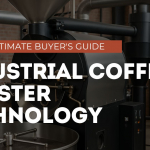Have you ever wondered what goes behind that first sip of your morning coffee? Those rich, aromatic beans are the result of a meticulous roasting process. Commercial coffee roasters are the unsung heroes, transforming green coffee beans into the flavorful gems that fuel our day. These specialized machines are designed to roast large batches of coffee beans with precision and consistency, ensuring a high-quality end product that tantalizes your taste buds.
Understanding Commercial Coffee Roasters
Commercial coffee roasters are the backbone of any coffee business, from cozy coffee shop, roastery, or large-scale coffee production facility. These machines are the workhorses behind perfectly roasted coffee. Unlike the green, unroasted beans you might see at a specialty store, commercial roasters transform these beans through a precise process called coffee bean roasting. This process unlocks their unique flavors and aromas, allowing roasters to achieve a desired “roast profile” – light, medium, or dark – depending on their preferences. They come in various types, like drum and fluid bed roasters, with capacities ranging from 1kg for small-batch roasters to a whopping 30kg for high-volume production.
The Roasting Process
In the realm of specialty coffee, roasting is both an art and a science, executed through the meticulously designed industrial roasters. These machines apply precise heat and air flow to catalyze the Maillard reaction and other chemical changes within the coffee beans, transforming their chemical and physical properties. Mastery over this process is crucial, as it allows roasters to highlight specific flavor profiles and achieve a consistent roast across countless batches. Understanding the subtleties of roasting dynamics—the balance of temperature, time, and bean characteristics—is fundamental for crafting exceptional coffee.
1. Green Bean Preparation:
The journey begins with preparing the green coffee beans, carefully sorting and cleaning them to remove any defective or damaged beans, as well as impurities like twigs, stones, or other foreign objects. This crucial step ensures that only the highest quality beans make it into the roaster, laying the foundation for a truly exceptional final product.
Each roasted coffee bean is the union of over 800 volatile compounds contributing to its complex profile.
The sorted and cleaned green beans are stored in temperature and humidity-controlled silos or containers, maintaining their freshness and preventing premature aging until they are ready for roasting. When it’s time to roast, the automated system precisely weighs and measures out the desired batch size, which can range from 1kg to 30kg or more, depending on the capacity of the commercial coffee roaster.
Once prepared and measured, the green beans are loaded into the roasting chamber or drum of the commercial coffee roaster, ready to embark on their transformative journey.
2. Drying Stage:
As the heating system kicks into action, the beans are gradually exposed to increasing temperatures. The first stage, known as the drying phase, removes any remaining moisture from the beans. During this phase, the beans undergo minimal chemical changes, but the process is essential for preparing them for the subsequent roasting stages. If not properly dried, the beans may roast unevenly or develop undesirable flavors.
In this initial phase, the automated heating system gradually increases the temperature within the roasting chamber or drum. As the beans are heated, the automated roaster’s built-in airflow and exhaust systems play a vital role. These systems circulate hot air through the roasting chamber, evenly distributing heat and allowing the moisture to escape as water vapor. Sophisticated sensors continuously monitor the airflow and moisture levels, making automatic adjustments as needed to maintain the optimal drying conditions.
As the drying stage nears completion, the automated roaster seamlessly transitions to the next phase of the roasting process.
3. Browning Stage:
Next comes the browning stage, where the real transformation begins. This pivotal phase is responsible for unlocking the beans’ rich, complex flavors and aromas, transforming their appearance from green to the familiar, enticing shades of brown.
During the browning stage, the automated heating system continues to increase the temperature within the roasting chamber or drum. Precise temperature controls and monitoring systems ensure that the heat rises at a carefully calibrated rate, allowing for the optimal chemical reactions to occur within the beans.
As the temperature rises, the beans’ natural sugars begin to caramelize, a process known as pyrolysis. This caramelization is responsible for the distinctive brown coloration that develops on the beans’ surface, as well as the initial nutty and toasted aromas that begin to emerge. Simultaneously, the automated roaster’s airflow and exhaust systems play a crucial role in facilitating the browning process. The circulation of hot air through the roasting chamber ensures even heat distribution, while the exhaust systems vent the initial release of volatile compounds and smoke produced during this stage.
The length of the browning stage can vary depending on factors such as the bean variety, roast profile, and the specific flavor characteristics desired by the roaster. As the beans reach the desired level of browning, the automated roaster seamlessly transitions into the final stage of the roasting process: the development stage.
4. Development Stage:
The final stage, known as the development phase, is where the beans truly come into their own. As the beans transition from the browning stage, the automated heating system continues to increase the temperature within the roasting chamber or drum, reaching its peak levels. Advanced temperature probes and control systems ensure that the heat curve is meticulously followed, allowing for the optimal development of the beans’ flavor compounds.
It is during this intense heat that the famed Maillard reaction and Strecker degradation take place. The Maillard reaction, a complex series of chemical transformations, occurs when amino acids and reducing sugars within the beans interact, producing an extensive array of flavorful compounds, including those responsible for the beloved roasted and nutty notes.
Concurrently, the Strecker degradation, a separate chemical process, further contributes to the development of the beans’ unique flavor profile. This reaction involves the breakdown of amino acids, releasing a diverse range of volatile compounds that impart rich, deep aromas and tastes, often described as fruity, floral, or even spicy notes.
Throughout the development stage, the automated roaster’s airflow and exhaust systems play a crucial role in facilitating these chemical reactions. The circulation of hot air through the roasting chamber ensures even heat distribution, while the exhaust systems vent the increasing release of volatile compounds and smoke produced during this intense phase.
5. Cooling stage:
Once the beans have reached the pinnacle of their flavor development during the intense heat of the roasting process, the beans are quickly cooled to stop the roasting process and preserve the desired flavors and aromas. This cooling process is just as important as the roasting itself, as it prevents the beans from becoming over-roasted or developing undesirable flavors.
As the development stage concludes, the automated roaster initiates the cooling process by introducing a powerful flow of cool air into the roasting chamber or drum. This sudden influx of cold air rapidly reduces the temperature of the roasted beans, preventing them from over-roasting or developing any undesirable burnt or ashy flavors. In some advanced commercial roasters, the cooling stage may also involve the use of specialized cooling trays or cyclones, which further enhance the cooling process and facilitate the separation of any remaining chaff or debris from the roasted beans.
6. Collecting the Final Product:
The collection stage often employs a cooling tray or receptacle to ensure that any latent heat is dissipated. With each batch of roasted beans, the commercial coffee roaster has transformed simple green seeds into a complex and flavorful product, ready to be savored by coffee lovers around the world.
Conclusion
Commercial coffee roasters are the unsung heroes behind every perfectly roasted batch of coffee beans. From controlling the roasting process with precision to ensuring consistent quality and meeting high demand, these machines play a crucial role in the coffee industry.
As you savor your next cup of coffee, take a moment to appreciate the intricate process and specialized equipment involved in bringing those flavors to life. And if you’re a true coffee enthusiast, consider exploring locally roasted coffee or even trying your hand at roasting your own beans for the freshest, most flavorful experience.




